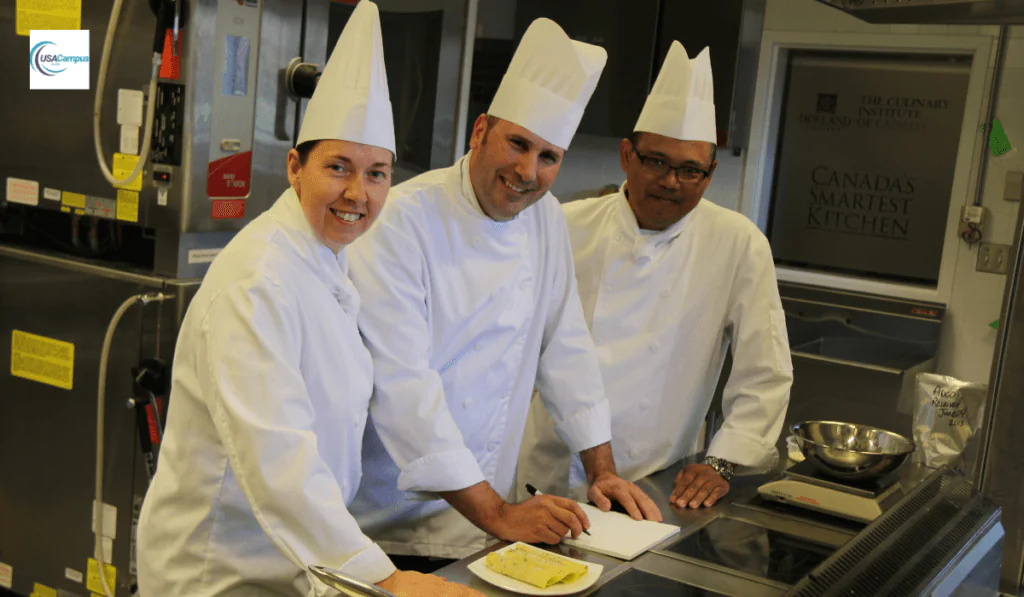
Canada is home to numerous prestigious culinary arts programs that reflect the country’s rich multiculturalism. In order to perfect their craft, obtain practical experience, and expand their professional network, aspiring chefs and culinary experts frequently research the top culinary schools.
This article will take you to journey of the best culinary arts institutes in Canada, breaking them down in their background, courses offered, facilities, teachers, admissions requirements, tuition, and future employment opportunities.
Admission Criteria for Culinary Arts Institutes in Canada
Each institution has its own specific admission criteria, but there are common elements across the board. This article outlines the general admission criteria for culinary arts institutes in Canada, focusing on academic requirements, portfolio submissions, personal statements, letters of recommendation, interviews, and other relevant factors.

General Admission Criteria
1. Academic Requirements
- High School Diploma or Equivalent: Applicants must have to complet secondary education with a high school diploma or equivalent. Some programs may specify prerequisite courses such as English, Mathematics, or Science.
- GPA Requirements: While specific GPA requirements can vary, many culinary arts programs prefer candidates with a solid academic record. A minimum GPA of 2.0 to 3.0 on a 4.0 scale is commonly expected.
2. Portfolio Submission
- Work Samples: Many culinary institutes require applicants to submit a portfolio showcasing their culinary skills and creativity. This portfolio may include photographs of dishes prepared by the applicant, recipes, and any culinary projects or competitions they have participated in.
- Video Submissions: Some programs may request a video demonstrating the applicant’s cooking techniques, plating skills, and overall kitchen proficiency.
3. Personal Statement
Statement of Intent: A personal statement or statement of intent is often required. This document should outline the applicant’s passion for culinary arts, career goals, and reasons for choosing the specific institute. It should also highlight any relevant experience and skills.
4. Letters of Recommendation
References: Applicants are usually required to submit two to three letters of recommendation from teachers, mentors, or employers who can attest to their character, work ethic, and culinary potential. These letters should provide insights into the applicant’s abilities and dedication to the culinary field.
5. Interview
Personal Interview: Some institutes may conduct personal interviews as part of the admission process. The interview can be in-person, over the phone, or via video call. This allows the admissions committee to assess the applicant’s communication skills, passion for culinary arts, and suitability for the program.
Fees and Financial Aid
While pursuing a culinary arts degree in Canada can be expensive, students can effectively control their expenses by being aware of the fees and available financial assistance alternatives. An avg. costs of tuition and available financial aid is given in this article for some of the best culinary arts schools in Canada.
The average cost for a master’s in Culinary Arts in Canada is around 25,000 to 45,000 USD
Financial Aid
Government Loans and Grants:
- Canada Student Loan Program
- Provincial student loan programs (e.g. StudentAid BC, OSAP in Ontario)
- Canada Apprentice Loan (up to $4,000 interest-free per period of training for Red Seal trades)
- Apprenticeship Incentive Grant ($1,000 per year/level, up to $2,000 total)
- Apprenticeship Completion Grant (one-time $2,000 grant)
Scholarships and Bursaries:
- Many culinary schools offer their own scholarships and bursaries (e.g. Stratford Chefs School, George Brown College)
- Industry-specific scholarships like the Canadian Hospitality Foundation scholarships
- Ben’s Original Canada ‘Seat at the Table’ Scholarship ($25,000/year at select schools)
Top Culinary Arts Institutes in Canada
1. The Culinary Institute of Canada (CIC) – Holland College
Established in 1983, The Culinary Institute of Canada, located in Charlottetown, Prince Edward Island, is one of the most premier Culinary Arts Institutes in the country.
CIC has a tradition of excellence in culinary education. The institute is renowned for producing top-tier chefs and culinary professionals who excel in various culinary disciplines.
Programs and Courses
CIC provides a variety of culinary arts programs to meet the needs of students requirements. Major courses consist of:
- Culinary Arts Diploma: The Culinary Arts Diploma program is two years long and teaches students both basic and advanced cooking techniques, as well as how to run a kitchen and exhibit their food.
- Pastry Arts Diploma: Students enrolled in the Pastry Arts Diploma program learn the ins and outs of baking and pastry, honing their skills to produce delectable breads, sweets, and pastries.
- Culinary Management: Those interested in pursuing careers as culinary industry executives can enroll in a three-year program that blends the culinary arts with business management.

Facilities
The Culinary Institute of Canada has state-of-the-art facility, including modern kitchens, advanced level baking units, and a fine dining restaurant where students gain hands-on experience. The institute also has partnerships with local farms and fisheries, student has access tp fresh and high quality ingredients.
Faculty
CIC’s faculty comprises experienced chefs and industry professionals who bring a knowledge and experience to the classroom. The small student-teacher ratio for personalized attention and mentorship.
2. George Brown College – Chef School
History and Reputation
Toronto, Canada is home to Canada’s leading Culinary Arts Institutes. The Chef School at George Brown College has earned a stellar reputation for its innovative programs and commitment to culinary excellence.
Programs and Courses
The Chef School offers a wide range of programs, including:
- Culinary Management: This program covers essential culinary skills, kitchen management, and food safety. Students also learn about menu planning, cost control, and customer service.
- Baking and Pastry Arts: Focused on baking techniques, pastry creation, and dessert preparation, this program is ideal for those interested in pursuing a career in pastry arts.
- Culinary Arts – Italian: In partnership with the Italian Federation of Chefs, this program offers specialized training in Italian cuisine, including traditional cooking techniques and regional specialties.
Facilities
George Brown College’s Chef School features cutting-edge kitchens, baking labs, and a restaurant where students can hone their skills in a real-world setting. The school also has a wine lab and a chocolate laboratory for specialized training.
Faculty
The faculty at the Chef School consists of accomplished chefs, pastry chefs, and industry professionals who provide students with a wealth of knowledge and hands-on experience. Many faculty members have received national and international recognition for their contributions to the culinary arts.
Why you should pursue career as an Aircraft Maintenance Engineer ? | 7 Top Reasons
Aircraft maintenance Engineering in Canada
3. Pacific Institute of Culinary Arts (PICA)
History and Reputation
The Pacific Institute of Culinary Arts, located in Vancouver, British Columbia, is a premier Culinary Arts Institutes, known for its comprehensive training programs and emphasis on practical experience. Founded in 1997, PICA has quickly established itself as a leader in culinary education.
Programs and Courses
PICA offers a variety of programs designed to prepare students for careers in the culinary and hospitality industries. Key programs include:
- Culinary Arts Diploma: This program covers a wide range of culinary techniques, from basic knife skills to advanced cooking methods. Students also learn about kitchen management and food safety.
- Baking and Pastry Arts Diploma: Focused on the art of baking and pastry, this program teaches students how to create a variety of baked goods, desserts, and confections.
- Professional Culinary Arts Certificate: A shorter program designed for those looking to gain foundational culinary skills in a condensed timeframe.
Facilities
PICA boasts modern kitchens, baking labs, and a fine dining restaurant where students gain hands-on experience. The institute also has a dedicated wine and spirits education center, providing specialized training in beverage management.
Faculty
The faculty at PICA includes experienced chefs, pastry chefs, and industry professionals who bring a wealth of practical knowledge to the classroom. The small class sizes ensure personalized attention and mentorship.
4. Le Cordon Bleu Ottawa Culinary Arts Institute
History and Reputation
One of the most prominent Culinary Arts Institutes globally, Le Cordon Bleu, has a campus located in Ottawa, Ontario. Le Cordon Bleu Ottawa was founded in 1988 and offers students an elite education by fusing traditional French cooking methods with contemporary advancements.
Programs and Courses
Le Cordon Bleu Ottawa offers a range of programs designed to cater to different interests and career aspirations in the culinary field. Key programs include:
- Diplôme de Cuisine (Cuisine Diploma): This program covers classic French culinary techniques, from basic knife skills to advanced cooking methods. Students learn about menu planning, food presentation, and kitchen management.
- Diplôme de Pâtisserie (Diploma in Pastry Making): Focused on the art of pastry, this program teaches students how to create a variety of desserts, pastries, and confections using traditional French techniques.
- Grand Diplôme: A comprehensive program that combines the Diplôme de Cuisine and Diplôme de Pâtisserie, providing students with a well-rounded education in both culinary and pastry arts.
Facilities
Le Cordon Bleu Ottawa features state-of-the-art kitchens, pastry labs, and a fine dining restaurant where students gain hands-on experience. The institute also has a dedicated wine and spirits education center, providing specialized training in beverage management.

Faculty
The faculty at Le Cordon Bleu Ottawa consists of accomplished chefs and pastry chefs who have received national and international recognition for their contributions to the culinary arts. The small class sizes ensure personalized attention and mentorship.
5. Northern Alberta Institute of Technology (NAIT) – School of Culinary Arts and Baking
History and Reputation
Situated in Edmonton, Alberta, the Northern Alberta Institute of Technology (NAIT) is well-known for its extensive training programmes and focus on real-world experience. There is a strong history of culinary education excellence at NAIT’s School of Culinary Arts and Baking.
Programs and Courses
NAIT offers a variety of programs designed to prepare students for careers in the culinary and hospitality industries. Key programs include:
- Culinary Arts Diploma: This two-year program covers a wide range of culinary techniques, from basic knife skills to advanced cooking methods. Students also learn about kitchen management and food safety.
- Baking and Pastry: Focused on the art of baking and pastry, this program teaches students how to create a variety of baked goods, desserts, and confections.
- Professional Meat Cutting and Merchandising Certificate: A specialized program designed for those looking to gain foundational skills in meat cutting and merchandising.
Facilities
NAIT boasts modern kitchens, baking labs, and a fine dining restaurant where students gain hands-on experience. The institute also has a dedicated butchery and charcuterie lab, providing specialized training in meat processing and preservation.
Faculty
The faculty at NAIT includes experienced chefs, pastry chefs, and industry professionals who bring a wealth of practical knowledge to the classroom. The small class sizes ensure personalized attention and mentorship.
Career Prospects & Salary
Generally speaking Culinary Arts graduates in Canada generally have good job prospects, most of the time they get good opportunity to work in big cities like Vancouver, Toronto or Ontario. or else they can also get opportunity to work on Cruise.
Salary Expectations:
- Entry-level salaries typically range from $25,000 to $35,000 per year.
- With experience, chefs can earn $50,000+ annually, with top positions reaching six figures.
Conclusion
Choosing the best institute for culinary arts in Canada depends on various factors, including individual career goals, program offerings, facilities, and financial considerations.
The Culinary Institute of Canada, George Brown College, Pacific Institute of Culinary Arts, Le Cordon Bleu Ottawa, and the Northern Alberta Institute of Technology all offer exceptional culinary education and training, making them top choices for aspiring chefs and culinary professionals.
With their comprehensive programs, state-of-the-art facilities, experienced faculty, and strong industry connections, these institutes provide students with the skills and knowledge needed to succeed in the dynamic and competitive world of culinary arts.
I am Micheal V, a freelance blog writer. I have expertise in writing blog with interest in Travel, Education, Stock Market. I can help my customers to get Ad sense Approval, You can connect with me for any blog writing service on “usacampusguide@gmail.com“, by mentioning Subject as “Blog Writing Service”






